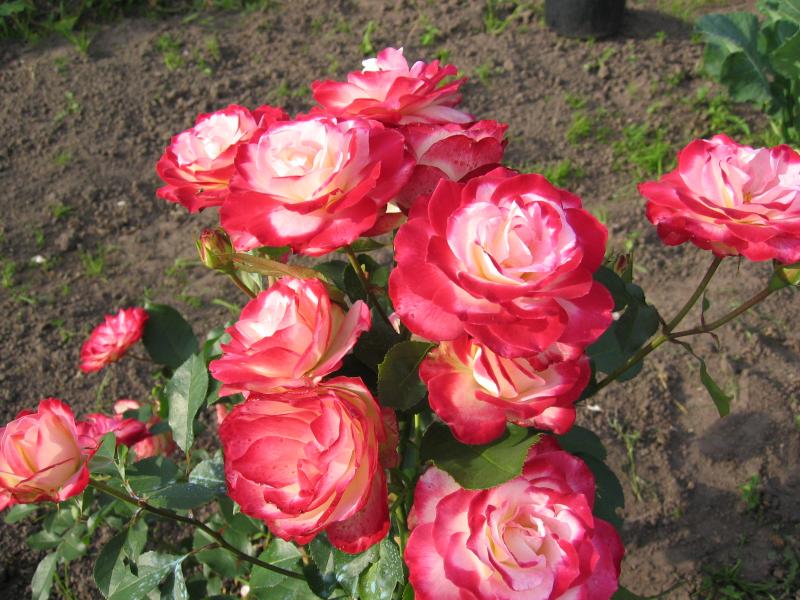Content:
Floribunda roses are excellent varieties to grow in your garden or country house. The advantage of these roses is their almost continuous flowering, which provides a delightful aroma and riot of colors on the site. Floribundas are bushy plants, but all inflorescences on each branch are collected in separate groups, so there are a lot of flowers on one stem. Such a spectacular look was achieved by crossing tea roses with musky roses. The result is roses that are not susceptible to the diseases typical of tea or musk varieties, and which can easily endure even severe frosts.
The inflorescences of roses belonging to the floribunda class are simple, double or semi-double. Petals can be small or large, with some flowers reaching 12 centimeters in diameter. Roses usually grow on spreading bushes, so they are planted in summer cottages or flower beds. One of the representatives of the floribunda group is a variety called Jubilee of the Prince of Monaco.
The history of the creation of the variety Anniversary of the Prince of Monaco
For the first time this rose was discovered in 2000 in France, when it was presented at an official exhibition. In the same year, the variety was entered into the official register, and now gardeners can purchase seeds in many countries around the world.
Rose of Monaco is unpretentious in care, therefore today it is widespread almost everywhere.
Features of the variety Prince of Monaco
The rose of this variety is rightfully called royal - it is not for nothing that the name contains a reference to the male heir to the throne. Having blossomed for the first time in early summer, roses delight their owners with bright, beautiful and graceful flowers until September. Rosa Jubilee du Prince de Monaco is resistant to unfavorable weather factors, because it perfectly tolerates dry summers, rainy autumn, and frosty winters without losing its shape. In addition, the plant is not susceptible to fungal diseases, from which other varieties of roses often suffer, and is not afraid of garden pests. The bush is of medium size, but does not grow throughout the site.
Below is a brief description of the plant:
- The height of the bush is 70-80 centimeters.
- Usually the flower diameter is 8-10 centimeters, but flowers with a diameter of 12 centimeters have been recorded.
- The plant has a rather weak aroma, so it does not have a headache or allergies.
- The rose prince of Monaco blooms for a very long time - from early June until the first frost.
- On average, each flower has 30-40 petals that hide yellow stamens in the middle.
- According to the international climate map, the plant can be planted in zones 3-6.
- The flowers are resistant to frost and rain.
Flowers easily withstand frosts down to -20 degrees and rainy periods. If you plant a bush in late April - early May, roses will delight the owner with blossoming buds the next season.
Features of planting and care
You should not buy young seedlings in spontaneous markets: as practice shows, an inexperienced gardener has a great risk of purchasing some wild bush instead of the cherished roses. When choosing seedlings, it is important to pay attention to their appearance, leaves and roots. The stems deserve special attention - only one of them should have a "non-living" appearance, the rest should be green, fresh and healthy.
Correct planting is the key to the prosperity and longevity of flowers. Despite the resistance of the variety to various adverse factors, it is necessary to choose the right planting site - the Prince of Monaco, like all other roses, is very picky about this aspect. This variety is very fond of the sun and heat, so it should be planted in an unshaded place, but if the owner lives in hot, arid latitudes, you will have to organize full watering, otherwise the bush will simply dry out.
The Prince de Monaco variety does not tolerate drafts, so the rose should be planted in a place protected from the winds. If this condition is not met, the flowers will fly around very quickly.
The soil should be rich in nitrogen and nutrients. To improve the germination of a new bush, it is recommended to dilute mullein 1 in 10 or bird droppings in the same proportion. In addition, the Prince of Monaco does not like a lot of moisture, so where there is groundwater or swampy soil, it will not grow. Usually, summer residents do not have such problems, since many people prefer to plant roses in flower beds or outside the yard, where the soil is dry and dense - and this is absolutely correct.
Roses do not require special care - it is enough to care for them in the same way as for other varieties. However, it is important to water them regularly, but at the same time this should be done early in the morning or in the evening, when the sun has already set, to avoid serious burns on the plant. You need to pour water right under the root - the plant really does not like it when leaves or stems are watered, moreover, it will be an excellent breeding ground for fungi and pests. The plant should not be waterlogged either, since prolonged watering will cause rotting of the roots, which will lead to the death of the rose. The ideal option would be a drip irrigation system that will provide enough moisture without harming the plant.
Advantages and disadvantages of the Prince of Monaco variety
Like any other plant, this type of rose has its own advantages and disadvantages. The advantages include:
- Abundant flowering throughout the summer and half of autumn, until the first frost.
- Unpretentious care - it is enough for the owner to regularly water the flowers and cut them once every six months.
- Resistance to unfavorable environmental factors, fungi and pests that become harmful to other varieties of garden roses.
- No overgrowth.
- Attractive appearance.
In general, this type of rose is perfect for planting on a personal plot. The disadvantages include only the almost complete absence of aroma. However, this can also be considered an advantage for people who are allergic to floral scents or hypersensitive to strong odors. Cut roses can be kept in the house - they will emit the slightest smell and will not cause constant ventilation of the room.
Rose Jubilee of the Prince of Monaco gained popularity for a reason - it is a truly amazingly beautiful flower that can decorate any flower bed. It will look great on any exterior.















